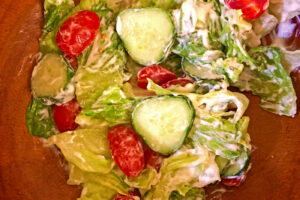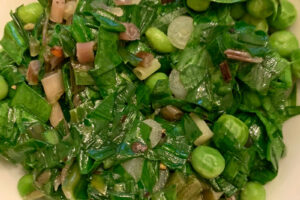Asparagus frittata is one of the very best and easiest to make. It’s particularly good in spring and summer when the vegetable is in season. I find that thin asparagus spears work best in this recipe. It requires no peeling, has little or no woody sections. and is the most tender. Also, it cooks very quickly.
The dish makes a perfect luncheon and can be completed in just a few minutes. I believe frittatas are best if not eaten directly out of the pan. Allow them to cool for a few minutes to get the most flavor from them. They are also excellent at room temperature.
I’ll have to confess, as I did in my autobiography, The Wrong Side of the Room: A Life in Music Theater, that my favorite way to eat this as a child was in a sandwich. My mother placed any cold leftover frittata on sandwich bread. She would give me this treat to pack in my school lunch.
Admittedly, my fellow students did not share my enthusiasm for this lunch. By the time that I unwrapped the sandwich at school, the bread had turned green, and I nearly cleared the table as people exclaimed, “What the hell are you eating?” It didn’t bother me a bit. They, who probably had never tasted asparagus in those 1950s days, had no idea what they were missing.
A well seasoned cast-iron skillet is best for making frittatas. However, with this recipe almost any skillet will do because it tends to stick to the pan less than other varieties.
Use enough asparagus to fill the skillet. Make sure your spears are trimmed to fit the size of your pan. Also be certain to dry the washed spears thoroughly with paper towels, or they will not brown properly.
Heat the olive oil to medium, place the spears in the pan, turning them until they are lightly browned and tender.
Meanwhile, beat six eggs thoroughly and add some grated Parmigiano, salt and pepper to taste. Turn up the heat to high and pour the egg mixture over the asparagus in the pan. Shake the pan to prevent sticking. Run a spatula around the edges, and tip the pan in all directions so that any uncooked egg flows underneath. Check with your spatula to be sure the frittata isn’t sticking.
When it is golden brown, carry the pan over to the sink and invert the frittata onto a plate, catching as much of the drippings as possible.

Asparagus Frittata
Return the skillet to the heat. If it looks as though it needs more olive oil, add a little extra. Then slide the frittata into the hot oil, and cook just until the underside is done. When finished invert again onto a plate and let it rest for a few minutes before serving.
To print or download the recipe, click here.
To read more stories about my Sicilian heritage and unusual food treats, check out The Wrong Side of the Room: A Life in Music Theater here.




